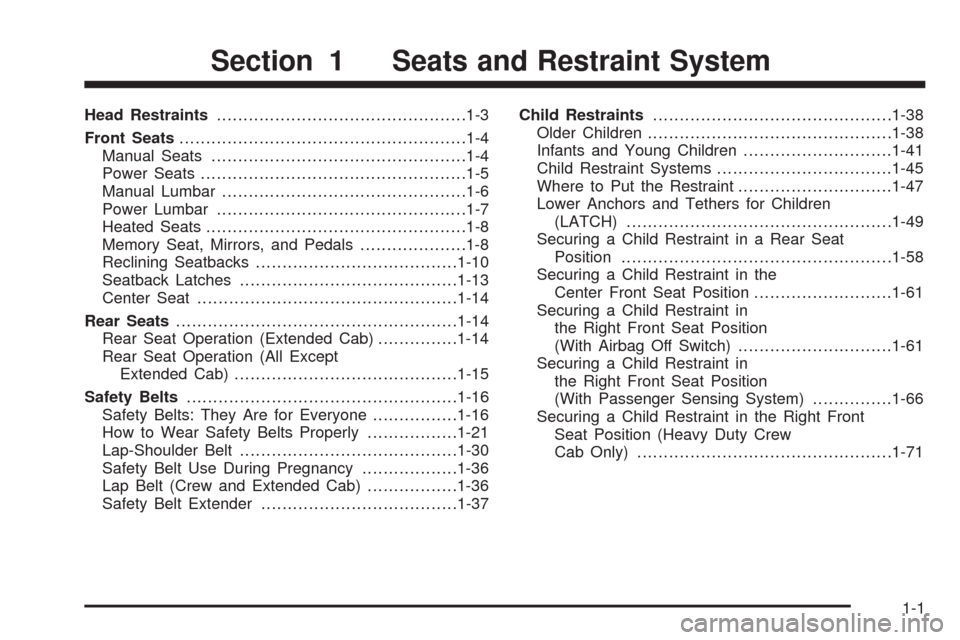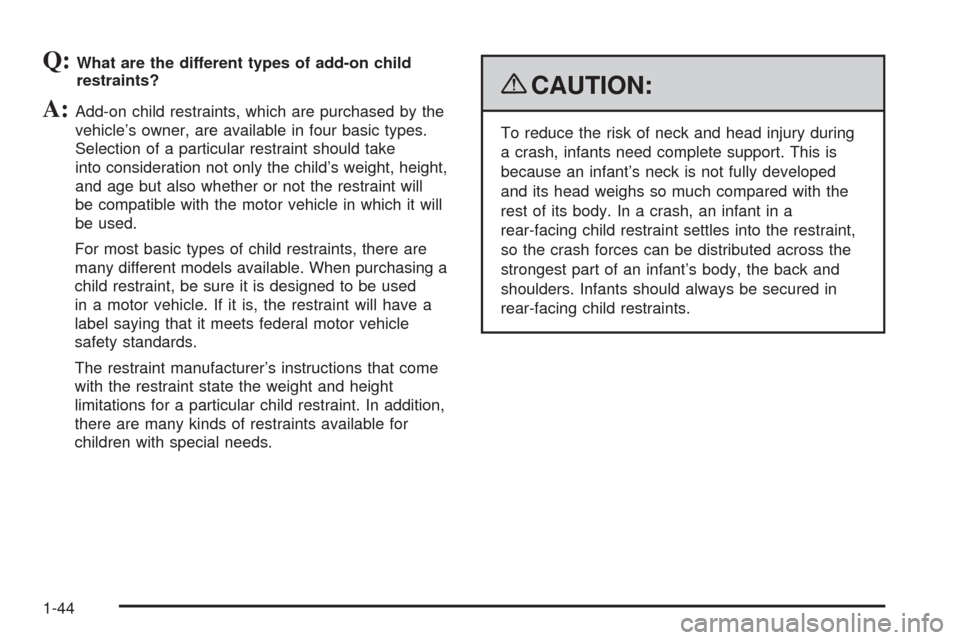Page 7 of 600

Head Restraints...............................................1-3
Front Seats......................................................1-4
Manual Seats................................................1-4
Power Seats..................................................1-5
Manual Lumbar..............................................1-6
Power Lumbar ...............................................1-7
Heated Seats.................................................1-8
Memory Seat, Mirrors, and Pedals....................1-8
Reclining Seatbacks......................................1-10
Seatback Latches.........................................1-13
Center Seat.................................................1-14
Rear Seats.....................................................1-14
Rear Seat Operation (Extended Cab)...............1-14
Rear Seat Operation (All Except
Extended Cab)..........................................1-15
Safety Belts...................................................1-16
Safety Belts: They Are for Everyone................1-16
How to Wear Safety Belts Properly.................1-21
Lap-Shoulder Belt.........................................1-30
Safety Belt Use During Pregnancy..................1-36
Lap Belt (Crew and Extended Cab).................1-36
Safety Belt Extender.....................................1-37Child Restraints.............................................1-38
Older Children..............................................1-38
Infants and Young Children............................1-41
Child Restraint Systems.................................1-45
Where to Put the Restraint.............................1-47
Lower Anchors and Tethers for Children
(LATCH)..................................................1-49
Securing a Child Restraint in a Rear Seat
Position...................................................1-58
Securing a Child Restraint in the
Center Front Seat Position..........................1-61
Securing a Child Restraint in
the Right Front Seat Position
(With Airbag Off Switch).............................1-61
Securing a Child Restraint in
the Right Front Seat Position
(With Passenger Sensing System)...............1-66
Securing a Child Restraint in the Right Front
Seat Position (Heavy Duty Crew
Cab Only)...............................................
.1-71
Section 1 Seats and Restraint System
1-1
Page 37 of 600
3. Push the latch plate into the buckle until it clicks.
Pull up on the latch plate to make sure it is secure.
If the belt is not long enough, seeSafety Belt
Extender on page 1-37.
If the latch plate will not go fully into the buckle,
check if the correct buckle is being used.
Position the release button on the buckle so that
the safety belt could be quickly unbuckled if
necessary.
4. If equipped with a shoulder belt height adjuster,
move it to the height that is right for you. See
“Shoulder Belt Height Adjustment” later in this
section.5. To make the lap part tight, pull up on the
shoulder belt.
It may be necessary to pull stitching on the safety
belt through the latch plate to fully tighten the
lap belt on smaller occupants.
1-31
Page 43 of 600
To make the belt shorter, pull its free end as shown
until the belt is snug.
If the belt is not long enough, seeSafety Belt Extender
on page 1-37.
Make sure the release button on the buckle is positioned
so you would be able to unbuckle the safety belt
quickly if necessary.
Safety Belt Extender
If the safety belt will fasten around you, you should use it.
But if a safety belt is not long enough, your
dealer/retailer will order you an extender. When you go
in to order it, take the heaviest coat you will wear,
so the extender will be long enough for you. To help
avoid personal injury, do not let someone else use
it, and use it only for the seat it is made to �t. The
extender has been designed for adults. Never use it for
securing child seats. To wear it, attach it to the
regular safety belt. For more information, see the
instruction sheet that comes with the extender.
1-37
Page 45 of 600

Q:What is the proper way to wear safety belts?
A:An older child should wear a lap-shoulder belt and
get the additional restraint a shoulder belt can
provide. The shoulder belt should not cross the face
or neck. The lap belt should �t snugly below the
hips, just touching the top of the thighs. This applies
belt force to the child’s pelvic bones in a crash. It
should never be worn over the abdomen, which
could cause severe or even fatal internal injuries in
a crash.
Also see “Rear Safety Belt Comfort Guides” under
Lap-Shoulder Belt on page 1-30.
According to accident statistics, children and infants are
safer when properly restrained in a child restraint
system or infant restraint system secured in a rear
seating position.
In a crash, children who are not buckled up can strike
other people who are buckled up, or can be thrown
out of the vehicle. Older children need to use safety
belts properly.{CAUTION:
Never do this.
Never allow two children to wear the same safety
belt. The safety belt can not properly spread the
impact forces. In a crash, the two children can be
crushed together and seriously injured. A safety
belt must be used by only one person at a time.
1-39
Page 48 of 600
{CAUTION:
Never do this.
Never hold an infant or a child while riding in a
vehicle. Due to crash forces, an infant or a child
will become so heavy it is not possible to hold it
during a crash. For example, in a crash at only
25 mph (40 km/h), a 12 lb (5.5 kg) infant will
suddenly become a 240 lb (110 kg) force on a
person’s arms. An infant should be secured in an
appropriate restraint.
1-42
Page 49 of 600
{CAUTION:
Never do this.
Children who are up against, or very close to, any
airbag when it in�ates can be seriously injured or
killed. Never put a rear-facing child restraint in the
right front seat. Secure a rear-facing child restraint
in a rear seat. It is also better to secure a
forward-facing child restraint in a rear seat. If you
must secure a forward-facing child restraint in the
right front seat, always move the front passenger
seat as far back as it will go.
1-43
Page 50 of 600

Q:What are the different types of add-on child
restraints?
A:Add-on child restraints, which are purchased by the
vehicle’s owner, are available in four basic types.
Selection of a particular restraint should take
into consideration not only the child’s weight, height,
and age but also whether or not the restraint will
be compatible with the motor vehicle in which it will
be used.
For most basic types of child restraints, there are
many different models available. When purchasing a
child restraint, be sure it is designed to be used
in a motor vehicle. If it is, the restraint will have a
label saying that it meets federal motor vehicle
safety standards.
The restraint manufacturer’s instructions that come
with the restraint state the weight and height
limitations for a particular child restraint. In addition,
there are many kinds of restraints available for
children with special needs.
{CAUTION:
To reduce the risk of neck and head injury during
a crash, infants need complete support. This is
because an infant’s neck is not fully developed
and its head weighs so much compared with the
rest of its body. In a crash, an infant in a
rear-facing child restraint settles into the restraint,
so the crash forces can be distributed across the
strongest part of an infant’s body, the back and
shoulders. Infants should always be secured in
rear-facing child restraints.
1-44
Page 51 of 600
{CAUTION:
A young child’s hip bones are still so small that
the vehicle’s regular safety belt may not remain
low on the hip bones, as it should. Instead, it may
settle up around the child’s abdomen. In a crash,
the belt would apply force on a body area that is
unprotected by any bony structure. This alone
could cause serious or fatal injuries. To reduce the
risk of serious or fatal injuries during a crash,
young children should always be secured in
appropriate child restraints.
Child Restraint Systems
A rear-facing infant
seat (A) provides restraint
with the seating surface
against the back of
the infant.
The harness system holds the infant in place and, in a
crash, acts to keep the infant positioned in the restraint.
A forward-facing child
seat (B) provides restraint
for the child’s body with the
harness.
1-45